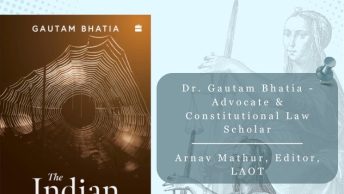To begin with, I must admit that there are certain areas of disagreement. Mr.Reddy starts with the premise that the objective of quotas is to ensure freedom of opportunity for social and economic advancement. Reservation is group-oriented, not individual oriented. Many Benches of the Supreme Court have upheld this view. One consequence of this view is that we can’t hope to empower all the individuals. There may be individuals in a group, who are not beneficiaries of this group-based reservation, but this is inevitable.
Secondly, I have not opposed judicial review of reservation. My only ground for opposing the latest stay of the two-Judge Bench is that it is not based on any reasoning at all.
Thirdly, Mr.Reddy says Constitution commands creation of a casteless society. I don’t think his belief is correct. Constitution only guarantees a right against caste-based discrimination. Caste is one of the prohibited grounds of discrimination along with others, such as sex, religion, region etc. We cannot, therefore, conclude that Constitution commands a sexless, a religion-less society. The word `only’ has to be noticed in Equality Articles. It prohibites discrimination on the basis of only caste, sex, etc. Courts have held that if you combine one of these prohibited grounds along with other non-prohibited grounds, then the discrimination resorted to is valid. It is now fairly clear that Mandal List/State Lists/ the Govt. of India’s lists are not based only on caste factor, but is based on a multiple criteria. The Mandal Commission for instance, evolved a multiple criteria, and gave different weightage to each criteria, and whichever caste secured 50 per cent weightage, then it was put in the list. Caste was considered as a unit, along with others, and this has been found valid in the Indra Sawhney judgment.
I admit my view that “if the modern-day governments instinctively, and by way of impulse and formal and informal studies consider a caste as backward, such consideration can be largely respected” is not tenable. I stand corrected, having found Mr.Reddy’s arguments very persuasive.
His elaboration of Justice Jeevan Reddy’s qualifications to identify backward classes is helpful. There are two stages. One is identification, and then revision. Indra Sawhney, no doubt, elaborates how a backward class can be identified. And it has approved the way the Mandal commission did it. The once-in-10 years survey is relevant for revision. Now, can the NCBC be faulted for its stand that a survey-based revision within 10 years is unlikely to result in removal of any class from the list? Still, I agree that there is a need to revamp the NCBC and even a direction could be issued to it by the Court to follow the guidelines if any in the Indra Sawhney judgment with regard to revision. The List was found valid in 1992, and the implementation started in 1993 with regard to public services. How could there have been so many classes within 10 years who might have become ineligible to be in the list in terms of SEBC criteria? It is in this context, I referred to the government’s instinctive feeling that a survey or a head-count may not be necessary to arrive at a conclusion which is obvious: that there may not be any caste which deserved to be removed from the list within the course of 10 years. Still, if the petitioners have any reason to challenge it, they could have approached the NCBC, with their complaint. They have not done so.
I am not sure -as Mr.Reddy thinks – that the Indra Sahney judgment requires the Government to undertake a fresh identification of SEBCs (as compared to revision for the purpose of exclusion and inclusion) on the basis of a head-count or a survey, however imperfect it may be. May be I need to study the relevant parts of the judgment, to convince myself. I am in agreement that a fresh survey, even similar to what the Mandal Commission had undertaken – could be initiated, but till such time, the existing lists need not be abandoned, as it would amount to depriving the benefits of the really needy classes. The 2-Judge Bench, the petitioners, and Mr.Reddy all seem to believe that much water has flown over the 10-15 years, that some communities, who do not fulfil any criteria of SEBC, are enjoying the benefits under the list. This assumption, in my view, has to be tested, by taking some representative castes, like Vokkaligas, for instance, and assess their relative backwardness. I have my reservations about the merits of doing a survey of the population, because it brings the proportionality element. Supposing if a State is predominantly illiterate, and socially backward, would not the proportionality element result in pruning of the list of OBCs in that state to unacceptable and even unconvincing level?
I agree that under the presumption of constitutionality principle, the burden of proof shifts to the Government, once the petitioner begins to show that the statute is unconstitutional. In this case, the petitioners have made only empty assertions and allegations. There is not even a prima facie ground. I did not say that the petitioners must prove absence of data. The Government has presented to the Court in its counter-affidavits why it thinks the data behind the OBC lists are objective material, citing Justice Pandian’s judgment in the Indra Sawhney, which considered similar objections against the data.
The petitioners’ main ground of attack is that 52 per cent OBC population figure is not credible. But they are not saying whether the 27 per cent quota is excessive or less. I agree with Mr.Reddy, that whatever percentage of SEBC population, they deserve protection. Therefore, if a 27 per cent quota is fixed, in view of the 50 per cent ceiling, why should there be any objection from the petitioners?
There are some indications that the two-Judge Bench was confused, and this led to lack of objectivity. In paragraph 31, they say that the lists relatable to Article 16(4) form the foundational base for Article 15(5), the source of the latest law. Now, both the Bench and the petitioners seem to challenge the credibility of the lists relatable to 16(4), even though Indra Sawhney Bench had upheld those lists. By entertaining the petitions against these lists, is not the two-Judge Bench shaking the basis of the 16(4) reservations also? If the lists are all right for 16(4), then the SC appears to say, it has no problems if creamy layer is excluded under 15(5), if the same lists are adopted under the Act being challenged. Therefore, SC would not appear to question the credibility of the lists as such. As far as the creamy layer also, the Bench would like to examine the Govt.’s stand in detail. It is in this conceptual confusion, and lack of self-confidence that it could stay the operation of Section 6, (many would deem it as overruling the Indra Sawhney judgment by a smaller bench), the Bench has perhaps found it desirable to keep S.6 in hold. Is not the Government correct in seeking a clarification whether it amounts to a stay, and if it is,, should not a larger Bench (than Indra Sawhney) hear the matter? After all, if the lists are not credible, because of the lack of survey etc, then the 16(4) quota also would come under attack.
( I am thankful to Dr.M.P.Raju, advocate, Supreme Court of India for helping me to understand some of the issues, and Mr.P.S.Krishnan, advisor to Human Resources Development Minister, Arjun Singh, for clarifying certain doubts. However, I am alone responsible for any gaps that the reader may come across in the post.)






Do OBCs really need reservation at all levels and at all courses.The Mandal commission did survey in early 80s.Should we not review the situation after more than 25 years and find whether those castes are still socially and educationally backward.Many castes in the central list are also on the state lists.Hence the argument of the NCBC is unacceptable.Does the government know how many OBC students graduate every year from
all management and engineering
colleges/institutes.When many southern states have reservation
for OBCs and with almost all states
having reservation for OBCs it cannot be claimed that they are
underrepresented in these courses.
1931 census,studies by Mandal commission in early 80s are used to
justify OBC quota in 2007. Are there no limits to irrational
decision making in India.
I have written on reservation issue in my blog in Tamil.
http://ravisrinivas.blogspot.com
See also my response on creamy layer question in EPW Demystifying the Anti-Creamy Layer – Economic & Political Weekly Vol XLII No 4
Jan27-Feb 2, 2007, Pp327-328
Dear Mr.Ravi Srinivas,
Thanks for the useful response to my and Vivek’s posts. In fact, only recently I read your response to Subramanian’s article in EPW. It was a very refreshing experience to read such analytical pieces in EPW on a subject, which is least understood in mainstream media.
I agree there is need for data on the number of existing OBC beneficiaries in educational institutions. I also agree after reading Vivek’s very persuasive post, that it is necessary to review whether castes in the SEBC list continue to fulfil the relevant criteria. If this has not been done, then it certainly requires judiciary’s intervention/direction. But to reach a premature conclusion that that the castes in the list must have necessarily graduated out of the SEBC category may not be correct. This is what the SC’s stay amounts to. Now, the SC has said the list for 15(5) must be distinct from that of 16(4), and freshly determined. This is also a question, where I agree, I do not have a clear view, even though I have reservations whether it is fair to infer that Parliament intended a fresh determination for A.15(5) as the SC and the petitioners seem to assume in the latest case.
The question whether the OBCs are underrepresented the Central Educational Institutions, and not those run by States, where I agree, OBC quota is already there. For this also, one would require data, which is not difficult to get.
But is it irrational to use the 1931 census as the base, and Mandal Commission’s studies of 80s to justify OBC quota in 2007? No doubt, we need fresh data, but the absence of such data alone does not make the existing ones irrelevant and unusable, as long as there is a transparent and reasonable process to include and exclude eligible/ineligible castes under the OBC list -which we have.
Thanks Mr. V.Venkatesan and Mr. Vivek Reddy. It’s easily the best legalistic debate one could have come across in the blogosphere on Indian Constitutional law. The more one read such debates the better equipped one gets to critically understand the interpretation of the world’s longest written constitution.
The readers want more of such enlightening debates, for sure.
The spirit is highly laudable with which arguments-for and against- have been put forth on the interim stay order of the Apex court, on the Reservation issue. In fact it serves great journalistic obligation as it provides great insights into the issues introspected in-depth and the other crucial issues that apparently have been overlooked in the adjudication process.
Reservations issue, certainly, is likely to have a considerably long and meaningful life. The intelligentsia across the diverse spectrum of all walks of life is likely to stay engulfed in this debate, even after the final verdict is out. But intellectually stimulating debates of present nature would certainly assist realisation of the objectives of social justice and I would not be surprised if it may very well guide the policy formulation to whatever extent.
Mr. Vekatesan has used an adage “why should we throw the baby with the bathwater?” I also wonder in a symbolic sense “When does the baby grow up?” I mean our country in its 60th year of independence ought to have sorted out the initial ‘teething’ problems in respect of the settling a uniform minimal standard of living for the whole population.
We certainly want that “the baby grows to become strong and independent.” I mean affirmative action specially in form of reservations is ought to be a temporary arrangement that’s to be implemented so effectively that it attains its objective in the shortest period and then it’s buried deep inside in the books of history.
Lastly, but not the least, it is a pleasure being a reader of this blog.
With warm regards.
Dear Mr.V.Venkatesan
Thanks for your comments.I think that reservation in jobs and reservation in education have to be based on different reasoning.When one is denied a government job there are other avenues but when one is denied
admission to IIT/IIM on basis
of caste based reservation there are no equivalent options.We have few institutes that are world class
and these happen to be IITs,IIMs,
IISc etc.Hence in admissions to these institutions caste based
quotas are not the right approach.
I would prefer an affirmative action type where the overall deprivation is taken into account
so that deprivation/factors like
gender, economic status,education
of parents etc are taken in to
account.The Moily report says that
the 27% reservation would benefit
mostly OBCs who are already advanced.Its silence on creamy layer issue is eloquent enough to
draw conclusions. The SC judgment
refers to this fact. It is no wonder that Thanthai Periyar Dravidar Kazhagam burnt copies
of the Moily panel in protest.
I think we need data and clarity
on the need/relevance of reservations.Even if say a Yes
to reservations it will be a
qualified one.
Dear Mr. Ravi Srinivas,
I understand your concern for the general category students. But we need to think about the issue dispassionately. Do we agree with the philosophy of SEBC reservations in educational institutions? If yes, then we need to ask whether our objections against the present method of SEBC identification are valid. The Government uses the OBC lists for public employment for the educational institutions. Now, there are Constitutional dilemmas in doing so, and the SC is not very convinced. Should the Govt. do a fresh determination for SEBCs for educational instiutions, or can it use the existing OBC lists prepared for public employment? Now, there are conflicting views on this, the SC has not yet formed a definite view. The second issue is creamy layer applicability for educational institutions. On this also, the SC has not formed a definite view, because of the Government’s reservations – explained in its counter-affidavits – in doing so. I am glad you are in favour of non-caste indicators to assess SEBC. If you look at the Mandal methodology – as explained in the Indra Sahney judgment – it is mostly non-caste indicators which have been given weightage in a 22 point scale (for 11 indicators). If a caste members secure (that is more than 50% weightage) good weightage in this scale, then it is in the list. The Govt. list includes castes in States lists only if they are also on the Mandal list. Now, the correctness of using caste as a unit for convenience – I understand there can be ethical and philosophical objections – has been tested in Indra Sawhney and has been approved because caste is a reality and it is a useful tool to assess a group’s backwardness. Just imagine there are no castes. How will we assess SEBC in a country as large as ours? Each individual may have to be assessed and no sample survey can succeed to give a correct picture. I understand there are alternatives in the form of a deprivation index which have been suggested – one for example by Yogendra Yadav. These alternative proposals need to be debated for their feasibility. I agree we need more data and clarity on the question of OBC quota in educational institutions.
that the constitution demands the creation of a casteless society may be true.
I say this with reference to the CADs where the object of Article 17 was a caste less society.
A question then arises is whether gov reservation policy is a means to achieve this end or otherwise?
Mr.V.Venkatesan
I will respond to your comments later.Thanks for your response.
Are you the one who writes in
The Frontline.I just read the
articles/interviews in the recent issue of Frontline.I am from
Tamilnadu and I do know some
facts about the ‘success’ story that is projected in the issue.
Tamilnadu model is a wrong model.
Even a dalit magazine that are pro-OBC quota has pointed out that in TN the major beneficiaries are
the OBCs and dalits have many
problems with the reservation
system in Tamil Nadu.This never
gets expressed in the English
media.Frankly speaking I find
that Frontline stories on this
issue lack obejectivity.
quota
Dear Mr.Aditya Swarup,
I haven’t read the CAD with ref. to Art.17. But on the face of it, one can say that removal of untouchability is an end in itself, whether it leads to the desirable/ethical objective of casteless society or not. Just because the supposed objective is not being served effectively, the importance of Art.17 does not diminish.
The Govt. reservation policy is certainly not a means to achieve the utopian goal of casteless society. The objective of reservation policy under Art.16(4) is empowerment of backward classes, and ensure their due representation in services. Is the corresponding objective valid for SEBC reservation under Article 15(4) and (5)? Well, that is a debatable issue; I find force in the argument that Article 15(4) and (5) are required to achieve the ends of 16(4).
Dear Mr.Ravi Srinivas,
Your guess is correct. I would like to know what that Tamil Magazine has said about the so-called success story in TN, and why Dalits are unhappy with the OBC quotas. I would appreciate if you are specific, and give us more insights on this.
Dear Mr.V.Vekatesan
See this link
http://www.keetru.com/dalithmurasu/nov06/nagoor_kani.html
I will give another link.
Keetru hosts issues of Dalit Murasu
and many other magazines.
Dear Mr.Ravi Srinivas,
Thanks for the links. I will get back after reading them.